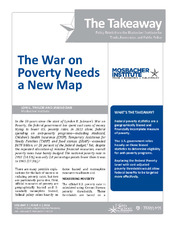| dc.creator | Taylor, Lori L. | |
| dc.creator | Dar, Jawad | |
| dc.date.accessioned | 2015-02-05T23:50:37Z | |
| dc.date.available | 2015-02-05T23:50:37Z | |
| dc.date.issued | 2014-12 | |
| dc.identifier.uri | https://hdl.handle.net/1969.1/153685 | |
| dc.description.abstract | Since the start of Lyndon B. Johnson’s War on Poverty, the federal government has spent vast sums of money trying to lower U.S. poverty rates. Yet, despite the repeated allocation of massive financial resources, overall poverty rates have barely budged. There are two particularly pervasive possible explanations for that lack of success. First, official measures of poverty are geographically biased and financially incomplete. Second, federal policy relies heavily on those biased and incomplete measures to allocate aid. Despite the difficulties, adjusting the federal poverty thresholds used to determine eligibility for anti-poverty programs is the right thing to do. If the U.S. is going to win the War on Poverty, it needs a new map. | en |
| dc.language.iso | en_US | |
| dc.publisher | Mosbacher Institute for Trade, Economics & Public Policy | |
| dc.relation.ispartofseries | Volume 5;Issue 6 | |
| dc.subject | poverty | en |
| dc.subject | FPL | en |
| dc.subject | cost-of-living | en |
| dc.title | The War on Poverty Needs a New Map | en |
| dc.type | Article | en |
| dc.contributor.sponsor | Bush School of Government and Public Service | |


